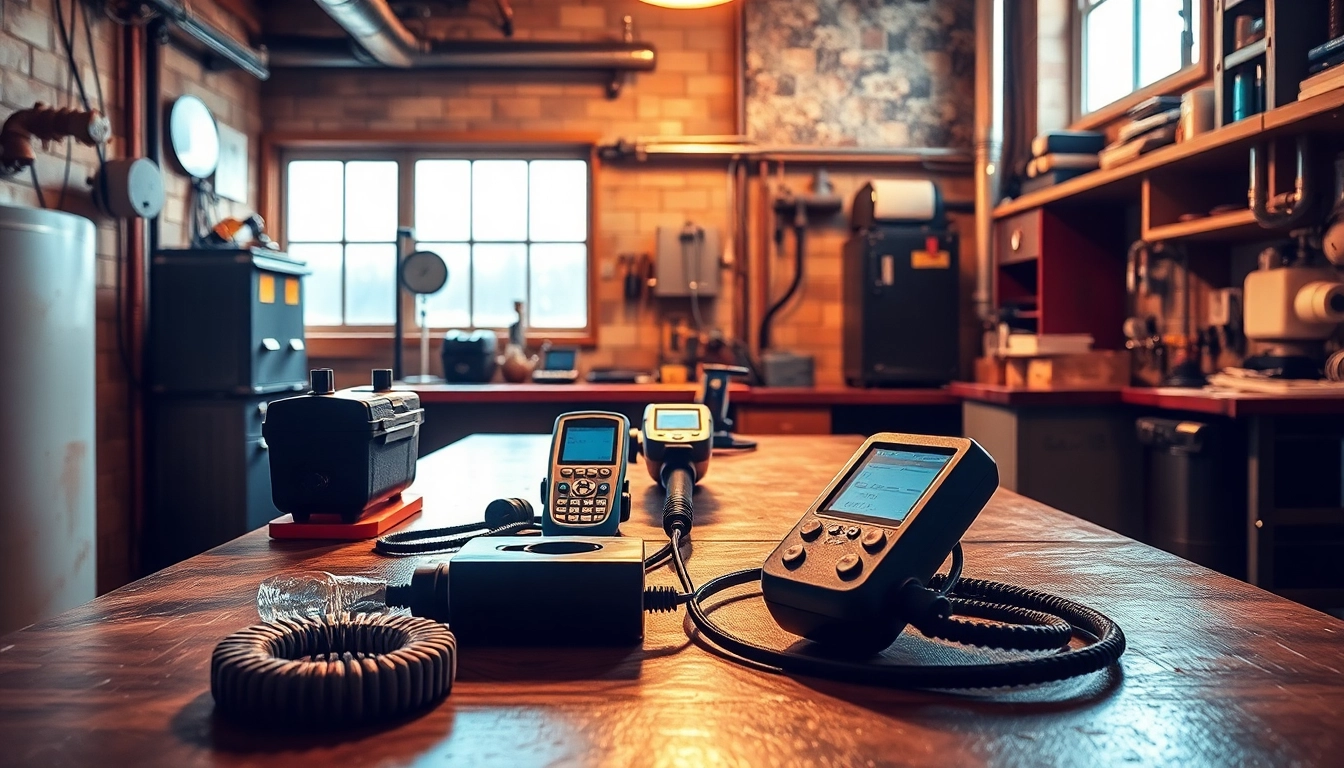Understanding Plumbing Leak Detection
What is Plumbing Leak Detection?
Plumbing leak detection is a crucial process used to identify and locate leaks within a plumbing system before they escalate into severe issues. Leaks can occur in various places, including pipes, faucets, and fixtures, and can lead to significant water damage, increased water bills, and even mold growth if left untreated. By employing various methods and technologies, homeowners and professionals can quickly spot leaks and take action to address them efficiently. Understanding the importance of effective plumbing leak detection serves as the first step in protecting your home and minimizing costly damages. For expert assistance, check out our Plumbing Leak Detection services.
Common Causes of Plumbing Leaks
Understanding the causes of plumbing leaks can help homeowners identify potential problems before they emerge. Common causes include:
- Corroded Pipes: Over time, pipes can corrode due to age and the materials used. This corrosion weakens the pipes and leads to leaks.
- High Water Pressure: Excessively high water pressure can stress pipes and joints, causing them to crack or break.
- Improper Installation: Poorly installed plumbing systems are prone to leaks as they may not have proper sealing or alignment.
- Temperature Changes: Fluctuations in temperature can cause pipes to expand and contract, leading to potential cracks and leaks.
- Clogs: Grease, hair, and debris can create blockages, leading to pressure buildup that results in leaks.
Why Timely Detection Matters
The earlier a leak is detected, the easier and less expensive it is to repair. Timely plumbing leak detection can significantly reduce water waste, lower utility bills, and prevent extensive property damage. Ignoring the signs of potential leaks or delaying detection can lead to severe repercussions, including structural damage, mold growth, and costly repairs. Therefore, investing in effective leak detection systems or methods is crucial for any homeowner looking to maintain a healthy and safe living environment.
Signs You Have a Leak
Visible Indicators of Plumbing Leak Detection
Being proactive in identifying potential plumbing leaks is key to preventing damage and can often start with visible signs. Pay attention to:
- Water Stains: Look for brown or yellow stains on ceilings and walls, indicating leaks above.
- Mold Growth: Mold and mildew often thrive in damp environments, which are caused by leaks.
- Damaged Drywall: Bubbling or peeling paint and drywall indicate water infiltration.
Unexpected Water Bills and Other Subtle Signs
An unexpected spike in your water bill can be one of the earliest indicators of a plumbing leak. It’s essential to monitor your water usage and compare it with previous bills. Other subtle signs include:
- Unexplained Wet Areas: Puddles or overly damp areas on your lawn or foundation may point to underground leaks.
- Increased Humidity: Sudden increases in humidity levels within your home can suggest indoor leaks.
- Noise: If you hear running water when none is being used, it may indicate a leak.
Impact of Ignoring Plumbing Leak Detection
Ignoring the signs of leaks can lead to severe consequences over time. Aside from elevated water bills, prolonged leaks can cause:
- Structural Damage: Water leaks can weaken the structure of your home, causing potentially dangerous conditions.
- Mold Growth: Damp conditions foster mold and mildew, posing health risks to occupants.
- Contaminated Water Supply: Leaks can lead to sewage backflow or contamination, making drinking water unsafe.
Types of Plumbing Leak Detection Methods
Non-Invasive Techniques for Effective Plumbing Leak Detection
Non-invasive plumbing leak detection methods allow for leak identification without damaging walls, floors, or landscaping. These methods include:
- Acoustic Detection: This technique utilizes sound waves to listen for leaks in pipes. Professionals use specialized equipment to amplify the sound of leaks.
- Thermal Imaging: Infrared cameras can detect temperature differences in walls, helping to identify moisture leaks without any physical inspection.
- Moisture Meters: These devices measure the moisture content in various materials, alerting technicians to potential leaks.
DIY Plumbing Leak Detection Techniques
Homeowners can use several DIY techniques to detect leaks, potentially saving time and money. These include:
- Water Meter Check: Conducting a simple water meter test can help determine if a leak exists. Turn off all water sources, check the meter reading, and then see if the meter moves after a period.
- Food Coloring Test: Adding food coloring to your toilet tank can help identify leaks. If the colored water appears in the bowl without flushing, a leak exists.
- Soapy Water Test: Applying a soapy solution to suspected leaky areas can reveal leaks through the formation of bubbles.
Professional Equipment for Plumbing Leak Detection
For those who prefer professional assistance, various advanced technologies make leak detection more efficient. Some examples include:
- Video Pipe Inspection: Cameras are inserted into pipes to visually identify leaks, blockages, and the condition of pipe interiors.
- Electronic Leak Detection Sensors: These sensors can identify and report water leaks immediately, often integrated into smart home systems.
- Tracer Gas Detection: Non-toxic gases are introduced into pipes, and their emergence at surface points indicates a leak location.
Steps to Perform Plumbing Leak Detection
Preparing Your Home for Plumbing Leak Detection
Before conducting leak detection, ensure your home is ready:
- Clear Areas: Clear any obstructions near sinks, toilets, and pipes to facilitate access.
- Turn Off Appliances: Ensure all appliances are not using water during the detection process.
- Document Existing Issues: Take notes or photos of visible damages before starting any detection work.
Step-by-Step Guide for DIY Plumbing Leak Detection
Follow these steps to effectively conduct DIY plumbing leak detection:
- Perform a water meter test to establish a baseline.
- Check toilets and fixtures with the food coloring test.
- Examine high-risk areas (under sinks) for visible water accumulation.
- Utilize a soapy water test on suspected leak sites.
- Assess external areas, such as the yard, for moisture issues.
When to Call a Professional for Plumbing Leak Detection
While DIY methods can be helpful, certain situations necessitate professional intervention. Consider calling experts when:
- You can’t locate the source of the leak after your initial checks.
- Visible damage exceeds minor stains or moisture.
- There are signs of mold that may indicate a deeper plumbing issue.
Maintaining Your Plumbing System
Regular Maintenance for Effective Plumbing Leak Detection
Consistent plumbing maintenance is essential for leak prevention and early detection. Homeowners can implement:
- Routine Inspections: Regularly inspect pipes and fixtures for signs of wear and tear.
- Drain Cleaning: Periodic drain cleaning prevents blockages that can lead to leaks.
- Water Pressure Monitoring: Check water pressure levels regularly to keep them in a safe range.
Investing in Quality Plumbing Fixtures
Investing in high-quality plumbing fixtures can drastically reduce the risk of leaks. Quality products generally offer better durability and performance, which leads to fewer repairs over time. Seek out reliable brands and consider features that enhance leak prevention.
Long-Term Benefits of Preventative Plumbing Leak Detection
Engaging in preventative plumbing leak detection offers numerous long-term benefits:
- Cost Savings: Timely detection prevents expensive repairs and increases water efficiency.
- Increased Property Value: A well-maintained plumbing system adds to overall property value.
- Health Benefits: Reduces the risk of mold, ensuring a healthier living environment.



